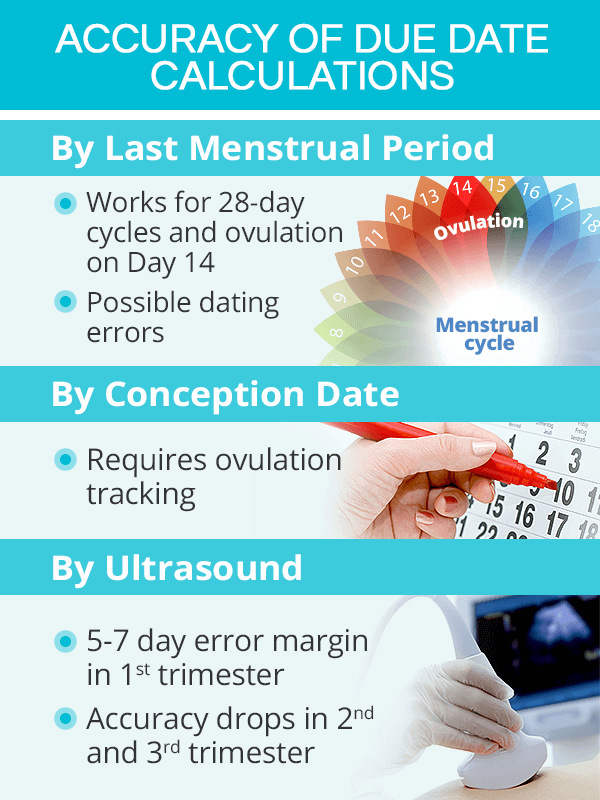Due Date Calculator
What is a Due Date Calculator?

A due date calculator, or a pregnancy calculator, is an internet-based tool that is used to obtain the baby's estimated date of delivery (EDD).
These estimations are based on the average duration of pregnancy, which is 40 weeks, or 280 days, although a healthy and normally developing pregnancy can last anywhere from 37 to 42 weeks.
A number of free pregnancy due date calculators is offered online by portals focused on pregnancy and female health. Besides an estimated due date, these calculators often make references of the baby's weight or size at various pregnancy stages.
How to Calculate Pregnancy Due Date?

There are three main ways through which an estimated due date can be obtained. They include the following:
Due Date Based on Last Period
The most common initial method of calculating the baby's due date uses a woman's last menstrual period.
It consists of adding 40 weeks, or 280 days, to the first day of the last menstrual period (LMP). This method is the most accurate for women with regular, 28-day menstrual cycles with ovulation taking place on Day 14. It is worth noting that in the first two weeks of gestation, a woman is not actually pregnant yet.
Due Date by Conception
Another possible method of obtaining the pregnancy due date is based on the conception day.
It involves counting 38 weeks, or 266 days, from the day a woman has conceived. For this method to be accurate, a woman has to be tracking ovulation since conception can only occur in that 24-hour window since egg release. As such, most women find it easier to recall their LMP rather than their ovulation.
Due Date by Ultrasound
Also called a dating scan, an ultrasound in the first trimester is the more accurate method of establishing the baby's gestational age and the respective pregnancy due date, especially in the case of women not knowing their LMP as well as those with irregular periods, irregular ovulation, or suspected pregnancy complications.
From the fifth week of gestation, the first structures of the developing embryo can be monitored through a transvaginal or transabdominal ultrasound. Assessing fetal development, particularly crown-rump length (CRL), gives a precise gestational age needed for estimating the baby's due date.
How Accurate are Pregnancy Due Dates?
Being the most accurate due date predictor, a first trimester ultrasound has a 5-7 day error margin; however, its accuracy decreases with time.
As such, the first pregnancy due date estimated from a woman's last menstrual period might be adjusted based on the findings of the first trimester ultrasound. However, second and third trimester ultrasounds are not usually considered for making pregnancy due date adjustments.

If due date obtained via first trimester ultrasound is within 5-7 days from LMP due date, the LMP due date should remain unchanged.
If the first trimester ultrasound differs from LMP due date by more than 7 days, the new pregnancy due date will be changed to the one obtained via ultrasound.
If the first ultrasound was done in the second trimester, and it differs from LMP due date by more than 7 days, its findings should replace LMP due date.
Key Takeaways
Pregnancy due date is one of the first and most important measurements taken in early pregnancy. Upon confirming that a woman is expecting, the expected date of delivery can be obtained with a due date calculator or manually by adding 40 weeks to the first day of a woman's last menstrual period. However, this method has its limitations as it applies to women who have 28-day cycles and regular ovulation taking place on Day 14. Aspiring mothers trying to conceive can also add 38 weeks to their conception date to estimate their pregnancy due date as long as they have been keeping track of their cycles with a fertility chart or ovulation trackers. Yet, the most accurate due date predictor is an ultrasound, which can measure fetal growth and produce gestational age. However, for an ultrasound to be precise, it should be done in the first trimester as its accuracy decreases as pregnancy progresses.
Sources
- American College of Obstetrics and Gynecology. (2017). Methods for estimating the Due Date. Retrieved April 30, 2019 from https://www.acog.org/Clinical-Guidance-and-Publications/Committee-Opinions/Committee-on-Obstetric-Practice/Methods-for-Estimating-the-Due-Date?IsMobileSet=false
- American Journal of Obstetrics and Gynecology. (2002). Comparison of pregnancy dating by last menstrual period, ultrasound scanning, and their combination. Retrieved April 30, 2019 from https://www.ncbi.nlm.nih.gov/pubmed/12501080
- American Pregnancy Association. (n.d.). Pregnancy Calculator. Retrieved April 30, 2019 from https://americanpregnancy.org/pregnancy-calculator/
- Health Direct. (n.d.). Due date calculator. Retrieved April 30, 2019 from https://www.pregnancybirthbaby.org.au/due-date-calculator
- Health Direct. (2018). Dating scan. Retrieved April 30, 2019 from https://www.pregnancybirthbaby.org.au/dating-scan
- National Health Service. (2018). Pregnancy due date calculator. Retrieved April 30, 2019 from https://www.nhs.uk/conditions/pregnancy-and-baby/due-date-calculator/
- National Health System. (2018). 12-week pregnancy dating scan. Retrieved April 30, 2019 from https://www.nhs.uk/conditions/pregnancy-and-baby/due-date-calculator/
- Stat Pears. (2019). Estimate date of delivery. Retrieved April 30, 2019 from https://www.ncbi.nlm.nih.gov/books/NBK536986/

 Due Date
Due Date Also Probable
Also Probable